532 nm Diode-Pumped Solid State (DPSS) Lasers

- 532 nm DPSS Lasers
- 10 mW or 40 mW Power Output
- Ø9.5 mm Package with M9 x 0.5 Threading
- Hermetically Sealed Package
Front
Rear
LDM56DJ
DPSS Laser
Mounting Flange
Application Idea
Our Laser Diode Driver Kits Include an
LD Controller, TEC Controller,
LD/TEC Mount, and Accessories
DJ532-10
532 nm, 10 mW

Please Wait

Features
- 532 nm Output
- 10 mW or 40 mW Output Power (CW)
- 12 mrad Beam Divergence
- M9 x 0.5 Threaded Housing
- Same Pin Spacing as Standard Ø5.6 mm Laser Diodes
- Compatible with the LDM56 Temperature-Controlled Mount
Thorlabs' compact 532 nm Diode-Pumped Solid State (DPSS) green laser modules are a combination of Nd:YVO4 and KTP crystals pumped by an 808 nm laser diode. The front window consists of a wedged glass filter, which blocks the IR source light and hermetically seals the module. DPSS lasers can be used like any typical semiconductor laser diode, but offer a much smaller beam divergence. Please note that these laser modules are intended for CW operation and should not be pulsed.
These lasers are compatible with our LDM56 temperature-controlled laser diode mount using the LDM56DJ mounting flange (sold below). The Ø2.0 mm pin spacing on the rear is identical to our Ø5.6 mm laser diodes. Efficiency is reduced outside of the operating temperature range (20 to 25 °C) as a result of the temperature sensitivity of the laser crystals. In the absence of a regulated heat sink, the pump laser current is enough to heat the laser far above 25 °C.
These lasers can be used with any of our M9-threaded aspheric lens adapters if the temperature of the DPSS laser is controlled. Compatibility with our wide range of SM1-threaded (1.035"-40) components is possible using our S1TM09 adapter. The unthreaded portion of the housing can also be secured inside our AD9.5F Collimator Adapter. When mounting these lasers, it should be noted that there is an X-Y position offset between the pins and the emitted beam. These lasers are manufactured such that the emitted beam is concentric with respect to the housing. If mounting by the pins instead of the M9-threaded front face, the emitted beam will be slightly off-centered from the mount. Please contact Tech Support for more details.
For best results, please follow all typical laser diode handling procedures. Please note that the DJ532-10 (10 mW) monitor current only represents the power of the IR pump laser and not the output of the green DPSS laser. For this reason, we recommend using the DJ532-10 with a constant current laser diode driver. The DJ532-40 does not contain a monitor photodiode.
Laser Safety and Classification
Safe practices and proper usage of safety equipment should be taken into consideration when operating lasers. The eye is susceptible to injury, even from very low levels of laser light. Thorlabs offers a range of laser safety accessories that can be used to reduce the risk of accidents or injuries. Laser emission in the visible and near infrared spectral ranges has the greatest potential for retinal injury, as the cornea and lens are transparent to those wavelengths, and the lens can focus the laser energy onto the retina.
Safe Practices and Light Safety Accessories
- Laser safety eyewear must be worn whenever working with Class 3 or 4 lasers.
- Regardless of laser class, Thorlabs recommends the use of laser safety eyewear whenever working with laser beams with non-negligible powers, since metallic tools such as screwdrivers can accidentally redirect a beam.
- Laser goggles designed for specific wavelengths should be clearly available near laser setups to protect the wearer from unintentional laser reflections.
- Goggles are marked with the wavelength range over which protection is afforded and the minimum optical density within that range.
- Laser Safety Curtains and Laser Safety Fabric shield other parts of the lab from high energy lasers.
- Blackout Materials can prevent direct or reflected light from leaving the experimental setup area.
- Thorlabs' Enclosure Systems can be used to contain optical setups to isolate or minimize laser hazards.
- A fiber-pigtailed laser should always be turned off before connecting it to or disconnecting it from another fiber, especially when the laser is at power levels above 10 mW.
- All beams should be terminated at the edge of the table, and laboratory doors should be closed whenever a laser is in use.
- Do not place laser beams at eye level.
- Carry out experiments on an optical table such that all laser beams travel horizontally.
- Remove unnecessary reflective items such as reflective jewelry (e.g., rings, watches, etc.) while working near the beam path.
- Be aware that lenses and other optical devices may reflect a portion of the incident beam from the front or rear surface.
- Operate a laser at the minimum power necessary for any operation.
- If possible, reduce the output power of a laser during alignment procedures.
- Use beam shutters and filters to reduce the beam power.
- Post appropriate warning signs or labels near laser setups or rooms.
- Use a laser sign with a lightbox if operating Class 3R or 4 lasers (i.e., lasers requiring the use of a safety interlock).
- Do not use Laser Viewing Cards in place of a proper Beam Trap.
Laser Classification
Lasers are categorized into different classes according to their ability to cause eye and other damage. The International Electrotechnical Commission (IEC) is a global organization that prepares and publishes international standards for all electrical, electronic, and related technologies. The IEC document 60825-1 outlines the safety of laser products. A description of each class of laser is given below:
| Class | Description | Warning Label |
|---|---|---|
| 1 | This class of laser is safe under all conditions of normal use, including use with optical instruments for intrabeam viewing. Lasers in this class do not emit radiation at levels that may cause injury during normal operation, and therefore the maximum permissible exposure (MPE) cannot be exceeded. Class 1 lasers can also include enclosed, high-power lasers where exposure to the radiation is not possible without opening or shutting down the laser. |  |
| 1M | Class 1M lasers are safe except when used in conjunction with optical components such as telescopes and microscopes. Lasers belonging to this class emit large-diameter or divergent beams, and the MPE cannot normally be exceeded unless focusing or imaging optics are used to narrow the beam. However, if the beam is refocused, the hazard may be increased and the class may be changed accordingly. |  |
| 2 | Class 2 lasers, which are limited to 1 mW of visible continuous-wave radiation, are safe because the blink reflex will limit the exposure in the eye to 0.25 seconds. This category only applies to visible radiation (400 - 700 nm). |  |
| 2M | Because of the blink reflex, this class of laser is classified as safe as long as the beam is not viewed through optical instruments. This laser class also applies to larger-diameter or diverging laser beams. |  |
| 3R | Class 3R lasers produce visible and invisible light that is hazardous under direct and specular-reflection viewing conditions. Eye injuries may occur if you directly view the beam, especially when using optical instruments. Lasers in this class are considered safe as long as they are handled with restricted beam viewing. The MPE can be exceeded with this class of laser; however, this presents a low risk level to injury. Visible, continuous-wave lasers in this class are limited to 5 mW of output power. |  |
| 3B | Class 3B lasers are hazardous to the eye if exposed directly. Diffuse reflections are usually not harmful, but may be when using higher-power Class 3B lasers. Safe handling of devices in this class includes wearing protective eyewear where direct viewing of the laser beam may occur. Lasers of this class must be equipped with a key switch and a safety interlock; moreover, laser safety signs should be used, such that the laser cannot be used without the safety light turning on. Laser products with power output near the upper range of Class 3B may also cause skin burns. |  |
| 4 | This class of laser may cause damage to the skin, and also to the eye, even from the viewing of diffuse reflections. These hazards may also apply to indirect or non-specular reflections of the beam, even from apparently matte surfaces. Great care must be taken when handling these lasers. They also represent a fire risk, because they may ignite combustible material. Class 4 lasers must be equipped with a key switch and a safety interlock. |  |
| All class 2 lasers (and higher) must display, in addition to the corresponding sign above, this triangular warning sign. |  |
|
| Posted Comments: | |
Ozan A
(posted 2024-02-09 17:00:58.177) Greetings,
Can we tune the laser wavelenght with the temperature controllers? cdolbashian
(posted 2024-02-16 11:46:07.0) Thank you for reaching out to us with this inquiry. While the answer is technically yes, the tuning range would only be within the operating range of 20-25°C. You would likely only see <1nm of change to the center wavelength within the operating range. I have contacted you directly to discuss this. user
(posted 2024-02-07 10:52:35.937) Hi. I have a DJ532-40 with the LDM56DJ flange and the laser and TEC controller. I would like to send the laser output in optical single mode PM fiber (such as the P3-488PM-FC-2) to clean the mode and the polarizarion. Can you suggest a lens and optomechanics to perform properly the coupling? Also the other output of the fiber must be collimated in order to be sent to an optical confocal microscope. cdolbashian
(posted 2024-02-19 10:57:06.0) Thank you for reaching out to us with this inquiry. For standard application inquiries, we would recommend emailing your local support office. In this case, Europe@thorlabs.com. Additionally, I have contacted you directly to discuss your application. Lukas J
(posted 2023-07-24 11:07:47.407) Hello,
we've purchased the DJ532-40 together with the starter set LTC56A (current & temperature controller and mount). When we operate the laser at 24°C and 330mA, the output power of the laser drifts from 10 to 5 mW (measured after coupling to a fiber, absolute power is not an issue since we didn't align so far). After some time (5-30 min) the laser power starts to oscillate. Are you aware of cases where the output power oscillates visibly? What might cause this oscillation? Instability due to temperature (although we've set the temperature of the controller to 24°C)?
We're thinking of switching to a laser diode such as the 520 nm L520P50. Do you know whether we will encounter the same phenomen as well?
Best regards,
Lukas jpolaris
(posted 2023-07-31 06:41:58.0) Thank you for contacting Thorlabs. In order to isolate the issue to the laser and/or mount, the power should be measured directly from the output of the laser (prior to fiber coupling). If the instability issues are not present when measuring directly from the laser, then the fiber coupling technique can be examined. Common causes of instability are backreflections entering the laser and thermal issues. The DJ532-40 laser requires the LDM56DJ mounting flange to properly seat the laser into the LDM56 mount. If you are already using this flange, it would be a good idea to check that it is properly tightened. If the power is noticeably higher after turning off the laser and letting it cool, this is evidence of thermal issues. As for your question regarding stability of L520P50, we would not expect drift from either L520P50 or DJ532-40, assuming there were no backreflections entering these lasers, the correct flange was used, and the temperature was stable. I have reached out to you directly to assist in troubleshooting these instability issues. Emanuel Keller
(posted 2022-03-16 03:37:30.93) DJ532-40, polarisation axis
In the "532 nm Diode-Pumped Solid State (DPSS) Lasers, Overview"
You are stating:
"The polarization of the DJ532-10 laser is perpendicular to the line made by pins 1 and 3 (see pin diagrams below) while the DJ532-40 laser has a polarization that is parallel to this same line."
We however observe the maximum transmission trough a linear polarisation filter at some 23° - 27° off this axis.
The question already came up. Unfortunately it has not been answered publicly.
Do you have an explanation for this contradicting observation?
In case this matters, we attempt to drive the Laser with about 20mW output power.
Best Regards
Emanuel cdolbashian
(posted 2022-04-20 04:54:13.0) Thank you for sharing this information with us. Following this feedback, we have investigated the polarization of several of these units. We have found no consistent polarization direction, and after some discussion with the vendor we have found that this is to be expected. As of now we are removing statements on this page which present incorrect information regarding the predictability of the polarization direction of these diodes. We have reached out to you directly to discuss a refund for your device. user
(posted 2021-11-19 18:36:58.267) Which controller is recommended? it is possible to use the DPSS DJ532-10 and DJ532-40 lasers with one of the OEM Current and temperature controller. In particular with the
ITC110 OEM Laser Diode and Temperature Controller, ±1 A / 12 W YLohia
(posted 2021-11-23 02:04:53.0) Thank you for contacting Thorlabs. For our DPSS lasers we recommend using the LDC205C and TED200C controllers. That being said, any laser diode current controller capable of supporting the pin code, current, and voltage requirements can be used (such as the ITC110). user
(posted 2021-08-30 16:41:02.407) I am interested to a laser for Raman spectroscopy and microscopy. The critical factors to be considered are the low linewidth, wavelength variation with temperature and beam quality. Can you give me more information about these properties? Do you suggest these DPSS 532nm for Raman application? YLohia
(posted 2021-09-01 10:45:44.0) Thank you for contacting Thorlabs. We have, in the past, measured the linewidth to be 11 MHz for the 10 mW version and about 30 MHz for the 40 mW laser. Please note that these are not specs and are not guaranteed (and they are dependent on laser drive current and the temperature setpoint combination). We also have not determined the temperature tuning coefficient, but it is essential to the proper operation of this DPSS laser to be mounted on to a temperature-controlled mount anyway, especially if wavelength-stability is required. The laser emits a single mode TEM00 beam with a divergence of 12 mrad (typical). The laser can, in principle, be used for Raman spectroscopy, depending on your other components and your requirements for spatial and spectral resolution. Our own soon-to-be-released Raman spectroscopy kit uses the FPV785M laser for 785 nm excitation: https://www.thorlabs.com/newgrouppage9.cfm?objectgroup_id=14427&pn=FPV785M Deepa Kasaragod
(posted 2020-10-16 22:18:20.477) Can I please know the optical power stability information of DJ532-40. YLohia
(posted 2020-10-19 03:12:59.0) Thank you for contacting Thorlabs. Unfortunately, we do not spec stability for component laser diodes as this spec is dependent on the drive electronics, mounting, and temperature control of the diode. JIMMY CRAFTON
(posted 2020-04-27 11:02:14.217) I am looking to scan a molecular iodine transition. Have used other off-the-shelf DPSS products in the past (Coherent, etc.) Three questions.
1) Assuming this is a single mode laser with coherence length of a few meters?
2) What is the approximate line width (~100 MHz or less)
3) What is the thermal wavelength tuning coefficient (i.e. about 0.04 nm/C) YLohia
(posted 2020-05-07 09:21:02.0) Thank you for contacting Thorlabs. Measuring the DJ532-10 (200mA, 25C) with our SA200 Scanning Fabry Perot Interferometer, we calculated a linewidth of ~10.9MHz which translates to a coherence length of ~27.5m. Following a similar procedure with the DJ532-40 (330mA, 24C), we calculated ~30MHz linewidth for a coherence length of ~10m.
Since this is a DPSS laser, thermal tuning does not have an impact on the final 532 nm wavelength. These lasers are sensitive to temperature and can only operate optimally within a small range of 20-25 C. The temperature tuning coefficient of the 808 nm pump diode used in this is ~0.25 nm/C. Jack Vandermolen
(posted 2020-01-15 22:26:05.76) Hello. I noticed the beam divergences for most of your other laser diodes are in degrees and around 10 in terms of order of magnitude; however, for the DJ532-40 and DJ532-10, the beam divergence is listed at about 12 mrad, which is much smaller of course. Is this supposed to be the case or is that a measurement in degrees. I would like to know so I know whether I will need to colliminate the light or not. Thank you. YLohia
(posted 2020-01-16 10:04:19.0) Hello, thank you for contacting Thorlabs. The low beam divergence spec is correct -- this is an artifact of the DPSS design of the laser. The beam size is around Ø50µm at the output face of the crystal in the DPSS. The divergence is typically around 12 mrad (could be as high as 15 mrad) from that point on. So collimation may not be necessary, depending on your application and requirements. We have also seen very low divergences (less than 5 mrad) as well. Given that the divergences can be very low, placing a short focal length lens can result in the beam being focused to a spot. If necessary, you could look into using long focal length aspheric lenses (f >= 100 mm). Antonin Delas
(posted 2019-12-06 03:25:47.837) Good morning,
For my application, I need a more powerful green DPSS. Is it possible to only buy the 9.5mm package, and use a custom 808nm diode?
Would it work with high powers?
Thanks a lot YLohia
(posted 2019-12-10 08:49:04.0) Hello, thank you for contacting Thorlabs. I have reached out to you directly to discuss the possibility of offering this. katrin.philipp
(posted 2019-02-27 13:42:56.677) Hi, I am also interested in the spectrum of DJ532-40 diode lasers and the coherence length. Could you please send me the same information you sent to jxxu (posted 2019-02-21 09:51:02.0). Thank you! llamb
(posted 2019-02-28 09:51:38.0) Thank you for your feedback. I have reached out to you directly. jxxu
(posted 2019-02-20 23:05:38.177) Hi,
Do you have the spectrum of DJ532-40 diode lasers? I want to know the FWHM of the longitudinal mode and the coherence length of the laser.
Thanks! YLohia
(posted 2019-02-21 09:51:02.0) Hello, thank you for contacting Thorlabs. Measuring the DJ532-10 (200mA, 25C) with our SA200 Scanning Fabry Perot Interferometer we calculated a linewidth of ~10.9MHz which translates to a coherence length of ~27.5m. Following a similar procedure with the DJ532-40 (330mA, 24C) we calculated ~30MHz linewidth for a coherence length of ~10m. jact
(posted 2018-12-04 10:11:49.25) Can you give any details of the residual IR (specifically 1064, but also 808) emitted from the device? We would actually want to use the 1064 as a seed in a DFM stage, so are hoping there could still be a small but usable level transmitted. YLohia
(posted 2018-12-04 11:14:16.0) Hello, thank you for contacting Thorlabs. The IR leakage at 808nm and 1064nm is on the order of ~1.0 uW each, depending on the variant of the DJ532 model, though this is not something we specify. I will reach out to you directly with more information on how the test was conducted. user
(posted 2018-10-04 10:30:20.797) Is the laser diode controller TLD001 compatible with the DPSS laser DJ532-40? Thanks. YLohia
(posted 2018-10-04 10:48:42.0) Hello, we do not recommend the TLD001 for the DJ532-40 since the driver maxes out at an output current of 200mA. This diode, however, has a typical operating current of 330mA (400mA max). Thus, we recommend the LDC205C instead. deepak.korhalkar
(posted 2018-04-07 06:03:03.883) Please specify Model No. of the Aspheric Lens ( with mount ) that must be used to collimate the DJ532-10.
I guess the output power will be variable if we vary the drive current. Kindly confirm & send the graph if you have.
Thanks YLohia
(posted 2018-04-09 03:11:12.0) Response from Yashasvi at Thorlabs USA: Hello, thank you for contacting Thorlabs. The beam size is around Ø50µm at the output face of the crystal in the DPSS. The divergence is typically around 12 mrad (could be as high as 15 mrad) from that point on. We have seen very low divergences (less than 5 mrad) as well. Given that the divergences can be very low, placing a short focal length lens can result in the beam being focused to a spot. Keeping this in mind, for general use, we do not recommend the use of collimation optics. If necessary, you could look into using long focal length aspheric lenses. We have a tutorial for picking an appropriate lens for single mode laser diode collimation here: https://www.thorlabs.com/newgrouppage9.cfm?objectgroup_id=1832&tabname=LD%20Collimation. The typical Optical Power vs Drive Current plot can be found on the spec sheet available on the website. Please note that we do not recommend this diode for pulsed operation. Sasha
(posted 2018-03-19 22:04:12.687) What is M^2 and ellipticity of the dpss laser 10 mw? YLohia
(posted 2018-03-26 09:26:55.0) Hello, thank you for contacting Thorlabs. Unfortunately, we do not test individual units for their M^2 and ellipticity, so we don't really have a spec for this. That being said, in subjective terms, the beam is quite circular. I will reach out to you directly with the data we do have regarding this. stuart.mirell
(posted 2016-02-16 18:56:25.0) What is the typical polarization extinction ratio of the 532 nm DJ532-10 DPSS laser? besembeson
(posted 2016-03-09 01:37:41.0) Response from Bweh at Thorlabs USA: Though the pump and second harmonic generation process that generates the output are highly polarized in nature, the measured linear PER is only in the 5-10dB possibly due to some ellipticity that is introduced prior to the output. kwbchang2009
(posted 2015-10-06 23:51:16.29) do you have the noise data on the output for this diode
please call me at 408 799 3595
or email data to me
kwbchang2009@gmail.com besembeson
(posted 2015-10-13 11:43:28.0) Response from Bweh at Thorlabs USA. We don't have a typical noise data (amplitude or frequency) at this time. When using this, remember that it is a diode pumped laser with a frequency doubling crystal and the nonlinear effect is sensitive to temperature so besides using a very stable current source, the operating temperature should also be optimized within the specified range for single mode operation. hallt
(posted 2015-04-07 16:27:19.143) I would be really excited if you had a DPSS module such as this WITHOUT the KTP crystal. Any chance of getting one of those? jlow
(posted 2015-04-15 04:45:02.0) Response from Jeremy at Thorlabs: This is not a module we have. I will contact you directly regarding the possibility of getting this. user
(posted 2014-08-18 15:25:36.167) Hi Jeremy:
"The polarization direction of DJ532-40 is parallel to the line made by pins 1 and 3. "
Are you sure? I checked with mine and found that it's ~40 degrees from the pin1-3 direction (horizontal of TCLDM9). Am I doing something wrong? jlow
(posted 2014-08-21 03:18:35.0) Response from Jeremy at Thorlabs: Since you did not leave your contact info, please contact us at techsupport@thorlabs.com and we will troubleshoot this issue. Thanks. rsuper
(posted 2014-04-02 18:44:45.803) What is the polarization axis with respect to the packaging pin layout? jlow
(posted 2014-04-03 09:10:50.0) Response from Jeremy at Thorlabs: The polarization direction of DJ532-40 is parallel to the line made by pins 1 and 3. For the DJ532-10, it is perpendicular to the line made by pins 1 and 3. busko
(posted 2013-04-03 17:59:51.263) After using DJ532-40 round half a year it getting hard to obtain TEM00 mode. Some time ago it helped to change the temperature, or to play with a current, but now I have no more ideas.. Laser is mounted in TCLDM9. Could you give an advice? Or should we buy a new one? jlow
(posted 2013-04-11 09:37:00.0) Response from Jeremy at Thorlabs: The typical lifetime for the DJ532-40 is around 5000 hours or so. We will get in contact with you directly to discuss about your DJ532-40. barney.william
(posted 2013-02-12 11:36:50.31) I am interested in modulating this laser at about 400 Hz. I saw the comment posted below about crystal state lifetimes being a limitation, but there was no further information.
Also, can this laser be fiber-coupled? jlow
(posted 2013-02-14 15:36:00.0) Response from Jeremy at Thorlabs: For the DJ532 series, we do not recommend modulating this (only use as a CW source). The reason for this is because one cannot get clean output signal if modulated. For example, within a 5ms pulse, the output is quite noisy and erratic. Also, the output is non-linear (because of the non-linear crystal in the DPSS). You could possibly fiber couple this with the right optics and mount. tcohen
(posted 2013-01-10 10:52:00.0) Response from Tim at Thorlabs: This is correct. The LDM9T and LDM21 use a flange for the mount’s taps with a center distance of 20.32mm as opposed to the TCLDM9’s 19.05mm. We chose to introduce a flange for this mount as testing on the TCLDM9 with the DJ532 series showed it was able to dissipate the heat generated by the DPSS. bbattle
(posted 2013-01-04 10:14:43.61) The TCLDM9DJ mounting flange for LD DJ532-10 does not fit the LDM9T mount: the distance between mounting screws needs to be 20mm, but are 19mm. jlow
(posted 2012-11-01 11:12:00.0) Response from Jeremy at Thorlabs: The linewidth for the DJ532-40 should be around 30MHz. oriol.alvarez
(posted 2012-10-31 09:00:29.72) Hello,
I could not find the spectral characteristics of this product. In particular I am interested in the linwidth (which should be < 30 pm).
Can I have more information on this please?
Thank you in advance jlow
(posted 2012-09-04 14:26:00.0) Response from Jeremy at Thorlabs: The photocurrent from the monitor photodiode only represents the power of the 808nm pump laser diode and is not indicative of the optical power output of the 532nm laser. Typically, the DJ532 is used with a constant current source. For example, for an OEM solution, you could use the LD1255R (http://www.thorlabs.com/NewGroupPage9.cfm?objectgroup_id=1366&pn=LD1255R). olivier.hignette
(posted 2012-09-03 15:05:31.0) I do not see any information about the photodiode current of a DJ-532-10 which would allow me to set up the gain with a EK1102 evaluation kit sharrell
(posted 2012-06-07 14:16:00.0) Response from Sean at Thorlabs to busco: Thank you for your feedback. You are indeed correct, the vaule for P0 in the Operating Current and Operating voltage entries on the spec sheet and web spec table for the DJ532-40 should be 40 mW. We are correcting this error and the spec sheet and website should be updated soon. busko
(posted 2012-06-06 07:10:58.0) There is a small mistake in a spec sheet for DJ532-40: "Operating Current @ P0 = 10 mW*. "
Should be 40 mW. tcohen
(posted 2012-05-11 16:04:00.0) Update from Tim at Thorlabs: The beam waist is about 50um located at the surface of the crystal. After testing two DJ532-10 units, the output is elliptically polarized and both units have PER (the power ratio between the max power axis and min power axis) between 13dB to 14dB. Measuring the DJ532-10 (200mA, 25C) with our SA200 Scanning Fabry Perot Interferometer we calculated a linewidth of ~10.9MHz which translates to a coherence length of ~27.5m. Following a similar procedure with the DJ532-40 (330mA, 24C) we calculated ~30MHz linewidth for a coherence length of ~10m. Thank you for your interest in these DPSS laser diodes. We are continuing to characterize these and will update the web presentation with more information. tcohen
(posted 2012-05-09 12:11:00.0) Response from Tim at Thorlabs: Thank you all for your feedback. We are working to update the web presentation in the near future to provide more information. For your immediate needs I will compile this data and update you shortly. ihp
(posted 2012-05-08 05:43:36.0) What is the coherence length of the DJ532-10?
Ib holmlid
(posted 2012-05-07 10:40:43.0) What is the polarization state of the laser beam from this DJ532 laser? tcohen
(posted 2012-04-19 12:05:00.0) Response from Tim at Thorlabs: Thank you for your feedback! There are a few things that may alter the performance of the DPSS when modulating the pump diode. Because the DJ532 has a laser diode which pumps a crystal, the lifetime of the energy states of the crystal will likely limit modulation speed. Also, the response is highly non-linear which will cause uneven pulses. I will contact you to continue this discussion. busko
(posted 2012-04-18 12:53:31.0) Could this laser be modulated by the current modulation (for example with pulse-peaker and TCLDM9 mount) or it is mostly designed for CW usage? gao53
(posted 2012-03-31 09:51:20.0) May I know the output beam diameter of this LD? Thanks. gao53
(posted 2012-03-30 11:01:05.0) What is the coherence length of this laser diode? bdada
(posted 2012-03-15 15:03:00.0) Response from Buki at Thorlabs:
Thank you for your feedback. The beam diameter is about 60um (FWHM) at the crystal surface which is about 1.35mm inside the device’s front window.
We are currently revising the specification sheet for this laser in order to provide more information.
Please contact TechSupport@thorlabs.com if you have additional questions. user
(posted 2012-03-12 11:30:03.0) What are the beam diameters (FWHM) for your DPSS laser modules? As the divergence is so small that becomes quite important. bdada
(posted 2011-12-29 11:53:00.0) Response from Buki at Thorlabs:
I would like to correct my former response. While the pin out of the DPSS laser is compatible with our temperature controlled mounts, we do not currently have a mounting flange designed to hold the DPSS laser in our temperature controlled mounts. We are working on making the mounting flange available soon. As a temporary solution, we can provide a custom mounting flange.
Please contact TechSupport@thorlabs.com if you have any questions. bdada
(posted 2011-12-27 15:40:00.0) Response from Buki at Thorlabs:
Thank you for your feedback. The DPSS lasers are compatible with our TCLDM9 temperature controlled mount. Please contact TechSupport@thorlabs.com if you have additional questions. user
(posted 2011-12-24 11:39:19.0) Is the DPSS laser compatible with your TCLDM9 or other LD mount in "Related Products" linked above? bdada
(posted 2011-11-03 16:59:00.0) Response from Buki at Thorlabs:
We have visible collimated laser modules that may be better suited to your alignment needs. Please use the link below to get more information:
http://www.thorlabs.com/NewGroupPage9.cfm?ObjectGroup_ID=1487&pn=CPS532#368
The DJ532-10 is a bare diode that will require a laser driver as well as a lens to get a collimated beam. We have contacted you to discuss your application and assist you in selecting the appropriate products. iain
(posted 2011-11-03 11:11:27.0) Would this laser (DJ532-10) be suitable as an alignment laser for a telescope? (It would need to be visible at a distance of about 50 m, and attenuated for safety.)
Does it require a specific power supply? Can it be operated from a battery? |

| Item # | DJ532-10 | DJ532-40 | ||||
|---|---|---|---|---|---|---|
| Min | Typical | Max | Min | Typical | Max | |
| Wavelength | 531 nm | 532 nm | 533 nm | 531 nm | 532 nm | 533 nm |
| Optical Output Power | - | 10 mW | 20 mW | - | 40 mW | 50 mW |
| Operating Current @ Poa | - | 220 mA | 250 mA | - | 330 mA | 400 mA |
| Operating Voltage @ Poa | - | 1.9 V | 2.2 V | - | 1.9 V | 2.2 V |
| Slope Efficencya | 0.1 W/A | 0.2 W/A | - | 0.1 W/A | 0.2 W/A | - |
| Beam Divergence, Full Angle | - | 12 mrad | 15 mrad | - | 12 mrad | 15 mrad |
| Pin Code | A | E | ||||
| LD Reverse Voltage (Max) | 2 V | 2 V | ||||
| Operating Temperature | 20 to 25 °C | 20 to 25 °C | ||||
| Storage Temperature | -30 to 70 °C | -30 to 70 °C | ||||
| Pin Diagramb | 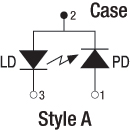 |
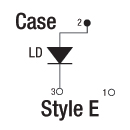 |
||||

The LDM56DJ mounting flange is used to secure a 532 nm DPSS laser to the LDM56(/M) temperature-controlled laser diode mount. To use, mount either the DJ532-10 or the DJ532-40 laser in the LDM56(/M) mount. Using the two 2-56 x 3/8" cap head screws provided with the flange, or with the mount itself, attach the flange to the mount.
Please note: this flange is sold separately from the LDM56(/M) Temperature Controlled Laser Diode Mount.
 Products Home
Products Home











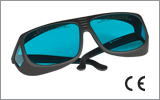
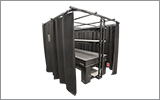
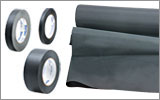

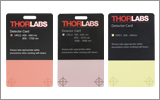
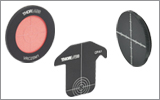
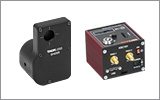
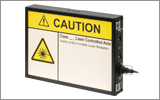

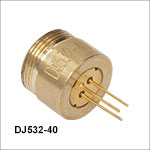
 Zoom
Zoom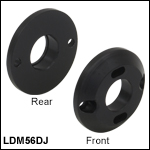
 532 nm Solid State Laser
532 nm Solid State Laser